
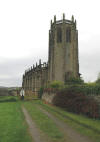


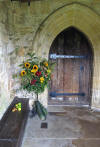
_small.jpg)





Yorkshire, England 2015 - Coxwold, Byland Abbey & Helmsley Castle
return to Yorkshire trip index
return to mdimage site index
It was only a few miles from our cottage to Coxwold and nearby Byland Abbey. Helmsley, which we visited later, was another ten miles or to the east, on narrow back roads.
Coxwold has a church with Norman roots - built in the early 1200s - and in great condition.
It was overcast, with light rain today.
note - you can enlarge any part of a picture by left-clicking in and then out again.
The Byland Tea Room, across the street from Byland Abbey, has charming interiors with Mouseman furniture, and the staff were inquisitive and advice-giving.
Besides the Tea Room they also operate B&B with a few rooms upstairs. The women working there had great accents and a sense of humor and our light lunch was really impressive.
 |
Byland Tea Room with guest rooms |
_small.jpg) |
today's lunch menu |
 |
Mouseman furniture |
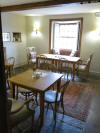 |
nice dining space |
 |
Byland Abbey | ||
 |
 |
Tea Room B&B and the Abbey to the east |
Byland Abbey
 |
Byland Abbey, with red highlights, see below |
This photo is from the Byland Abbey brochure, which states that "with its galleried upper walls, brightly painted decorations, and new handling of light and space, it reached a splendor far removed from the earlier Cistercian buildings with their relatively plain walls and small windows.....it was one of the first to break away fully from the Romanesque tradition".
 |
early Gothic architecture |
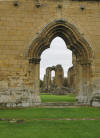 |
Byland was completed in 1177 |
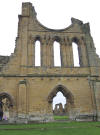 |
another light rain day |
 |
Nave |
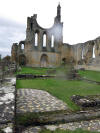 |
the floor was tiled in the 1200s |
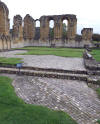 |
|
 |
 |
 |
fireplace | ||
 |
many fireplaces |
 |
good overview | ||
 |
at its height |
 |
Helmsley Castle
The first Helmsley Castle, made of wood, was built in 1120 by Walter L'Espec, a lifelong follower of King William II. Walter was given a tremendous land grant by Wm. II, but he died childless, his property holdings passing to his sister's de Roos family by marriage. In 1186, Robert de Roos constructed the Medieval castle. well, sort of.
An interesting bit of history - in his time, Walter L'Espec made a generous land grant of 6,000 acres to the Cistercian Order, enabling nearby Rievaulx Abbey to be built, while a generation later Robert de Roos the inheritor made a similarly generous land grant, which made Fountains Abbey possible.
Robert de Roos of Helmsley was one of 25 Barons selected to ensure that King John observed the conditions of the Magna Carta, signed in June 1215, nine hundred years ago. The Great Agreement limited the arbitrary authority of the Kings of England to imprison, condemn, or execute Barons, without some form of due process, in a rough sort of way.
But the Pope nullified it a few months later and then King John died of dysentery 15 months later, so the Magna Carta's significance faded until Edward I came to power. Historically, its symbolic value as 'the beginning of democratic ideals' was established.
Following Robert's death in 1227, de Roos descendants continued to reside in the Castle for the next five centuries.
go to next page - Bolton Castle & Wensleydale
return to Yorkshire trip index
return to mdimage site index